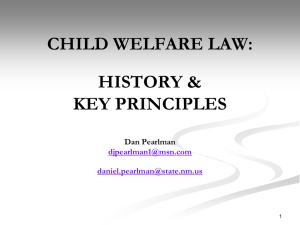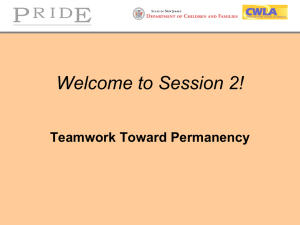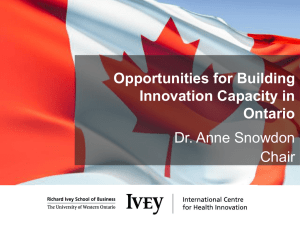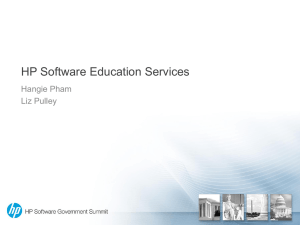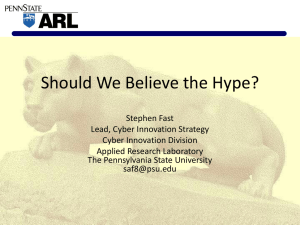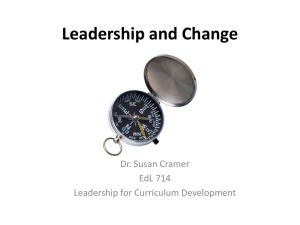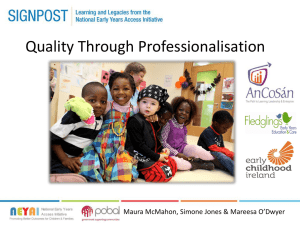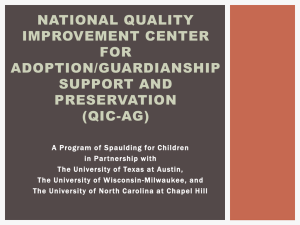PRIDE 7 - SLIDES - Continuing Family Relationships
advertisement
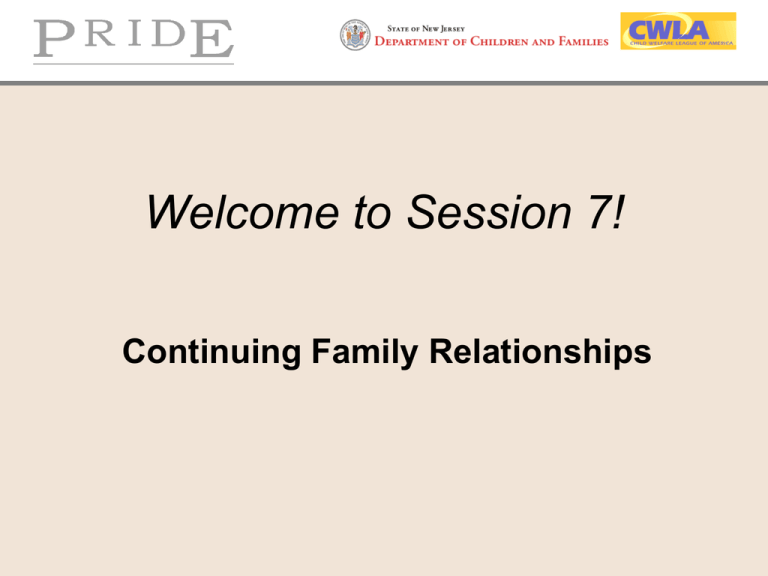
Welcome to Session 7! Continuing Family Relationships “Parking Lot” Are there any questions from previous sessions that we can answer now? Make-Up Dates If you’ve missed any of these classes, here are the upcoming training dates for Morris County: • Tuesdays and Thursdays in September, 6PM-9PM – September 6th, 8th, 13th, 15th, 20th, 22nd, 27th and 29th •Mondays and Wednesdays* in November, 6PM-9PM – November 7th, 9th, 15th, 17th, 21st, 23rd, 28th and 30th (*Note that the 15th and 17th are Tuesday and Thursday) There may be dates available in other counties. Check with your assigned Resource Family Support caseworker for details. Remember the Core Competencies of PRIDE: 1. Protecting and Nurturing Children 2. Meeting Children’s Developmental Needs and Addressing Developmental Delays 3. Supporting Relationships Between Children and Their Families 4. Connecting Children to Safe, Nurturing Relationships Intended to Last a Lifetime 5. Working as a Member of a Professional Team Supplemental Handouts for This Session • • • • • In-class exercise: Help Wanted Adoption Subsidy Program Kinship Legal Guardianship (KLG) White Paper Sample DYFS Part B Phone list The Two Jobs of DYFS … • Intervening in families where there is risk of abuse or neglect, and providing services to ensure that children are safe • To ensure that children have permanent families Permanency Means • Having a sense of one’s past • Having a legal and social status that comes from being a family member • Having safe, nurturing relationships meant to last a lifetime Permanency Means • Connections The relationships that will give children a sense of belonging and security • Continuity The ability of children to keep connections to people from their past and to know that the connections that sustain them today will be there for them in the future Importance of Permanent Connections • Did you feel a sense of belonging to a family while you were growing up? • What three words come to mind when you think about belonging to a family? • What was the most important contribution to your development that resulted from belonging to a family? • Did you ever worry, while you were growing up, about who would take care of you? • Who are the people in your life whom you believe will be there for you if something happens: if you are in trouble, get sick or need emotional support? Importance of Permanent Connections • Most people take for granted belonging to a family and being connected to people who will support them. • Most people assume that their parents would take care of them. • A feeling of belonging gives people a sense of history, roots and culture. It, also, provides us with a feeling of caring and being cared for, and a sense of identity and self-esteem. • The need for people on whom we can rely is not something that ends in childhood. Most adults continue to need permanent connections. The Child’s Clock • An important value of permanency practice is that it should be determined by the “child’s clock” because the child’s sense of time is different than an adult’s. • Not only is time experienced differently, but the same time frame in an adult’s life has a very different meaning in terms of development than it does for a child. The Child’s Clock 18 0 1 17 2 16 3 15 4 5 14 13 6 12 7 11 10 9 8 Think about what it was like to wait for something exciting to happen when you were six! Time seemed to drag on forever! The Child’s Clock Normal Development - Learning about social relationships - Learning academic subjects - Learning job & social skills - Learning to make good choices - Learning life skills (driving) - Forming important attachments - Experiencing world for 1st time - Learning to walk & talk - Learning to trust 18 0 1 17 2 16 3 15 4 5 14 13 6 12 7 11 10 9 8 - Going to school - Learning to ride a two-wheeler - Learning to read and write - Learning to get along w/others - Learning values The Child’s Clock Impact of Placement 18 0 1 17 2 16 Child enters “temporary” care - Should be developing vocabulary, social skills, sense of identity and culture, and exploring surroundings 3 15 Child achieves permanency 4 5 14 13 6 12 7 11 10 9 8 Adoption and Safe Families Act (ASFA) • Federal legislation enacted in 1997 • NJ implementation defined by law (N.J.S.A. 30:4C-11.1) • Expands the provisions of the Adoption Assistance and Child Welfare Act of 1980 – States must demonstrate commitment to prevention and reunifications services • Ensuring a child’s health, safety and timely permanency are DYFS’ paramount concern Adoption and Safe Families Act (ASFA) • DYFS must demonstrate that reasonable efforts were made to prevent a placement or state why they were not possible • Permanency options include safe return home, adoption, or “alternative” plan • When a child is in placement for 15 of 22 months (about a year), DYFS must present a permanent plan, which must include termination of parental rights (TPR) or a statement of why TPR is not appropriate, if reunification is not likely Adoption and Safe Families Act (ASFA) • In order to terminate parental rights, a judge must be satisfied that DYFS has met four specific standards, “based on the preponderance of the evidence presented” Adoption and Safe Families Act (ASFA) 1. The child's safety, health or development has been or will continue to be endangered by the parental relationship. 2. The parent is unwilling or unable to eliminate the harm facing the child or is unable or unwilling to provide a safe and stable home for the child and the delay of permanent placement will add to the harm. Such harm may include evidence that separating the child from his foster parents would cause serious and enduring emotional or psychological harm to the child. Adoption and Safe Families Act (ASFA) 3. The Division has made reasonable efforts to provide services to help the parent correct the circumstances which led to the child's placement outside the home and the court has considered alternatives to termination of parental rights. 4. Termination of parental rights will not do more harm than good. Concurrent Planning • While continuing efforts to reunify a family, DYFS may explore and prepare for an alternative plan, such as adoption • This is called “concurrent planning” • Concurrent planning is encouraged by ASFA, which identifies this as a means by which to achieve “early permanence” Concurrent Planning Families • A family that can commit to provide a permanent home while being able to support reunification • This is a family that is committed to the goal of permanence for the child Possible Permanency Outcomes • Return Home is appropriate when children can safely be returned to the care of their parents. • Adoption is selected when a termination of parental rights is achieved, either voluntarily or by trial, and the child is appropriate for adoption. • Guardianship with Kin is selected when children can live permanently with relatives or family friends and maintain a relationship with their birth family. In NJ, this is called Kinship Legal Guardianship, and may only be considered when adoption has been ruled out. • Alternative Permanent Living Arrangement is utilized for children with extreme behavioral problems that prevent them from thriving in a family setting and require an institutional placement. Termination of Parental Rights • Termination of Parental Rights (TPR) can be achieved in one of two ways: – As a result of a TPR or “Guardianship” trial, a Family Court Judge determines that DYFS has met its burden of proof by satisfying all four ASFA standards, and ORDERS that parental rights be terminated. In cases where parents are continually absent from court proceedings and they are not represented by counsel, a just can terminate and their parental rights by entering a “default” order. – Parents can voluntarily surrender their parental rights, and a judge must ACCEPT their surrender at a court hearing. Parents can also enter an “identified” surrender, where they identify a specific caregiver to become the adoptive parent. In the event that the caregiver is unable to adopt the child(ren) after rights are terminated, rights are restored, guardianship reverts back to DYFS and a TPR trial or some other court order must be obtained before the children can be adopted by another party. Help Wanted – Resource Parent! Using the blank paper provided, take a few moments to design a “Help Wanted” ad for resource parents. Be sure to include the competencies required to fulfill the job and include some information about the children who would be placed into their homes. Remember not to scare people away!!! Help Wanted – Resource Parent! • • • • Compare your ad to the “Help Wanted” ad PRIDEBook Page 250 Why is it necessary to understand this Job Description for being a resource parent? What kinds of specific things must a resource parent do? What are some challenges or difficulties a resource parent might face in doing this part of the job? How can the resource family use other team members to help with the task? Foster Care Adoption KLG Child remains in the custody of DYFS Yes No No Birth parents’ rights are terminated No Yes No Caregiving parents can make major decisions for child No Yes Yes Caregiving parents are financially responsible for child* No Yes Yes Child can have last name of the family No Yes No Child has inheritance rights No Yes No Child is covered by family’s insurance** No Yes Yes Legal Guardianship can be transferred (by will) No Yes No Permanency can be challenged by birth parents*** Yes No Yes * Adoption subsidy may be available for certain children considered “hard to place” and continues the foster care board rate and clothing allowance until the child is 18 (or 21 if attending school). KLG may include a monthly kinship care subsidy until the child is 18. ** Children in subsidized adoptions and KLG continue to receive Medicaid benefits until age 18 (or 21). *** Excluding rights of appeal. One Definition of Adoption Adoption is a means of meeting the developmental needs of a child by legally transferring ongoing parental responsibilities for that child from the birth parents to adoptive parents, recognizing that in the process, a new kinship network is created that forever links those two families together through the child. Adoption Definition • Did you agree or disagree with the definition? • What aspects of the definition did you agree with? • What aspects did you disagree with? Adopted children may have questions. Do you have the answers? • Who are my birth parents? Do I have brothers and sisters? Who are they? • What do I have in common with my birth family (appearance, genetic background, talents, behaviors, good/ bad traits)? • Why didn’t I grow up with my birth family like most other kids? • Am I secure in this family or will my birth family come someday and take me back? • Will I ever be able to meet my birth family? “Parking Lot” Are there any questions left unanswered from today’s session? CLOSURE • • • • Review Key Points, PRIDEBook Pages 253-267 Review You Need to Know!, PRIDEBook Pages 268-276 Read Birth Parent’s Perspective, PRIDEBook Page 277 Complete the PRIDE Connection exercise on PRIDEBook Pages 278-280 (copy in packet) • Read Making A Difference!, PRIDEBook Page 281-282 • Session 8: Planning for Change • Session 9: Making an Informed Decision
